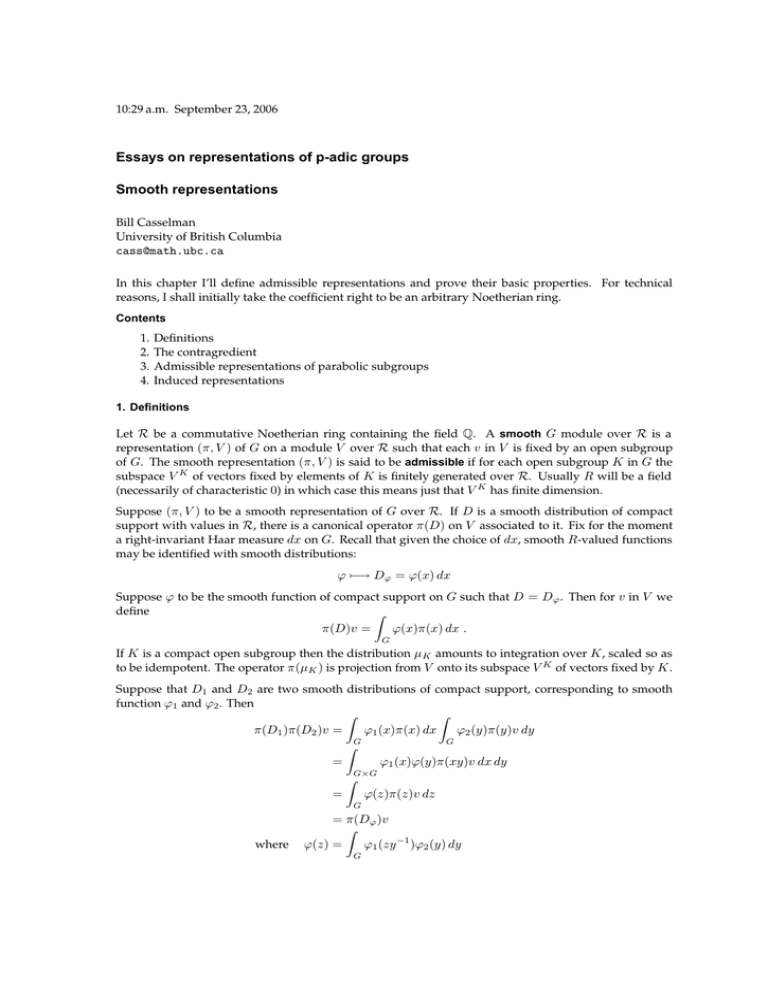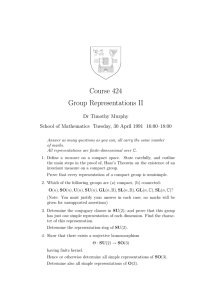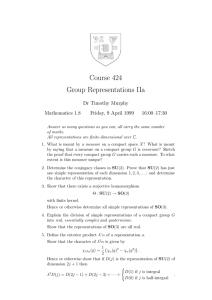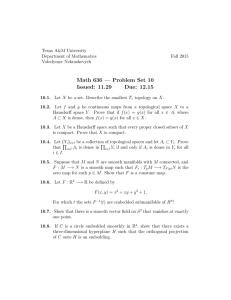Essays on representations of p-adic groups Smooth representations
advertisement

10:29 a.m. September 23, 2006
Essays on representations of p-adic groups
Smooth representations
Bill Casselman
University of British Columbia
cass@math.ubc.ca
In this chapter I’ll define admissible representations and prove their basic properties. For technical
reasons, I shall initially take the coefficient right to be an arbitrary Noetherian ring.
Contents
1.
2.
3.
4.
Definitions
The contragredient
Admissible representations of parabolic subgroups
Induced representations
1. Definitions
Let R be a commutative Noetherian ring containing the field Q. A smooth G module over R is a
representation (π, V ) of G on a module V over R such that each v in V is fixed by an open subgroup
of G. The smooth representation (π, V ) is said to be admissible if for each open subgroup K in G the
subspace V K of vectors fixed by elements of K is finitely generated over R. Usually R will be a field
(necessarily of characteristic 0) in which case this means just that V K has finite dimension.
Suppose (π, V ) to be a smooth representation of G over R. If D is a smooth distribution of compact
support with values in R, there is a canonical operator π(D) on V associated to it. Fix for the moment
a right-invariant Haar measure dx on G. Recall that given the choice of dx, smooth R-valued functions
may be identified with smooth distributions:
ϕ 7−→ Dϕ = ϕ(x) dx
Suppose ϕ to be the smooth function of compact support on G such that D = Dϕ . Then for v in V we
define
Z
ϕ(x)π(x) dx .
π(D)v =
G
If K is a compact open subgroup then the distribution µK amounts to integration over K , scaled so as
to be idempotent. The operator π(µK ) is projection from V onto its subspace V K of vectors fixed by K .
Suppose that D1 and D2 are two smooth distributions of compact support, corresponding to smooth
function ϕ1 and ϕ2 . Then
π(D1 )π(D2 )v =
=
Z
ZG
ϕ1 (x)π(x) dx
Z
G
ϕ2 (y)π(y)v dy
ϕ1 (x)ϕ(y)π(xy)v dx dy
ZG×G
=
ϕ(z)π(z)v dz
G
where
= π(Dϕ )v
Z
ϕ(z) =
ϕ1 (zy −1 )ϕ2 (y) dy
G
Smooth representations
2
The distribution Dϕ , also smooth and of compact support, is called the convolution D1 ∗ D2 of the two
operators D1 and D2 .
The point of allowing a smooth representation to have a rather arbitrary coefficient ring is essentially
a matter of book-keeping, so as to keep track of the kind of formulas that arise. If K is a compact
open subgroup of G, with V K is free over the ring R (which will often be the case) and D is right- and
left-invariant under K , then π(D) will be represented by a matrix whose coefficients are in R.
The space of smooth R-valued distributions of compact support, with convolution as product, is called
the Hecke algebra H R (G) of the group with coefficients in R. It does not have a multiplicative unit.
The subalgebra HR (G//K) of distributions right- and left- invariant with respect to a compact open
subgroup K has the multiplicative unit µ K .
For every closed subgroup H of G, define V (H) to be the subspace of V generated by the π(h)v − v for
h in H .
[projection] Proposition 1.1.
For any compact open subgroup K and smooth representation V , we have an equality
V (K) = {v ∈ V | π(µK )v = 0}
and a direct sum decomposition
Proof. If v is fixed by K∗ then
V = V (K) ⊕ V K .
X
1
π(k)v = π(µK )v
[K: K∗ ]
K/K∗
and of course trivially
X
1
v=v.
[K: K∗ ]
K/K∗
If we subtract the second from the first, we get
v − π(µK )v =
X
−1
π(k)v − v
[K: K∗ ]
K/K∗
[vkexactness] Corollary 1.2.
[abelian] Corollary 1.3.
The functor V
V K is exact for every compact open subgroup K of G.
If
0 −→ U −→ V −→ W −→ 0
is an exact sequence of smooth representations, V is admissible if and only if both U and W are.
Suppose K to be a fixed compact open subgroup of G. A smooth representation is
admissible if and only if its restriction to K is the direct sum of irreducible smooth representations of K ,
each with finite multiplicity.
[restriction-to-K] Proposition 1.4.
Proof. Choose a sequence of compact open subgroups Kn normal in K and with {1} as limit. Then V =
V (Kn ) ⊕ V Kn . The representation of K/Kn decomposes into a finite sum of irreducible representations
of K .
Smooth representations
3
2. The contragredient
If (π, V ) is an admissible representation of G, the smooth vectors in its linear dual HomR (V, R) define
its contragredient representation (e
π , Ve ). If K is a compact open subgroup of G then because V =
K
V + V (K) the subspace of K -fixed vectors in Ve is equal to
HomR (V K , R) .
From the exact sequence of R-modules
Rn −→ V K −→ 0
we deduce
0 −→ HomR (V K , R) −→ HomR (Rn , R) ∼
= Rn .
Therefore Ve K is finitely generated over R, and π
e is again admissible. If R is a field, which is often the
only case in which contragredients are significant, the assignment of π
e to π is exact, and the canonical
map from V into the contragredient of its contragredient will be an isomorphism.
If (π, V ) is an admissible representation of G then each space V K is stable under the centre ZG of G.
Assume for the moment that R is an algebraically closed field. The subgroup ZG ∩ K acts trivially on
it, and the quotient ZG /ZG ∩ K is finitely generated, so it elementary to see that V K decomposes into a
direct sum of primary components VωK parametrized by homomorphisms
ω: ZG −→ R× .
n
For each ω occurring there exists an integer n such that π(z)−ω(z) = 0 on VωK . If π is irreducible there
is just one component and the centre must act by scalars. In general, I call an admissible representation
centrally simple if this occurs, and in this case the character ζ π : ZG → R× by which ZG acts is called the
central character of π . If Z G acts through the character ω then π is called an ω -representation. For any
central character ω with values in R× the Hecke algebra HR,ω is that of uniformly smooth functions on
G compactly supported modulo ZG such that
f (zg) = ω(z)−1 f (g) .
If π is centrally simple with central character ω it becomes a module over this Hecke algebra:
π(f )v =
Z
G/ZG
which is well defined since f (zx)π(zx) = f (x)π(x).
f (x)π(x)v dx ,
Smooth representations
4
3. Admissible representations of parabolic subgroups
Let P = MP NP = M N be a parabolic subgroup of G, A = AP the split centre of MP . There exists a
basis of neighbourhoods of P of the form UM UN where UM is a compact open subgroup of M , UN is
one of N , and UM conjugates UN to itself.
♣ [induced-admissible] Since P \G is compact, Proposition 4.1 implies immediately:
bolic-induced-admissible] Proposition 3.1.
If (σ, U ) is an admissible representation of P then Ind(σ | P, G) is one of G.
The group M may be identified with a quotient of P , and therefore the admissible representations of M
may be identified with those of P trivial on N . It happens that there are no others:
[parabolic-admissible] Proposition 3.2.
Every admissible representation of P is trivial on N .
Proof. We begin with a preliminary result.
Suppose B to be a finitely generated module over the Noetherian ring R. If f : B → B is an
R-injection with the property that for each maximal ideal m of R the induced map fm : B/mB → B/mB
is also injective, then f is itself an isomorphism.
[noetherian] Lemma 3.3.
Proof. Let C be the quotient B/f (B). The exact sequence
f
0 −→ B −→ B −→ C −→ 0
induces for each m an exact sequence
fm
0 −→ B/mB −→ B/mB −→ C/mC −→ 0 .
It is by assumption that the left hand map is injective. Since F = R/m is a field and B is finitely generated,
the space B/mB is a finite-dimensional vector space over F , and therefore fm an isomorphism. Hence
C/mC = 0 for all m. The module C is Noetherian, which means that if C 6= 0, it possesses at least one
maximal proper submodule D. The quotient C/D must be isomorphic to R/m for some maximal ideal
m. But then C/mC 6= 0, a contradiction. Therefore C = 0 and f an isomorphism.
Let (π, V ) be an admissible representation of P , and suppose v in V . We want to show that π(n)v = v
for all n in N .
Let U = UM UN be a compact opne subgroup of P fixing v . We can find a in A such that a−1 U a ⊆ U .
For u in U we have
π(u)π(a)v = π(a)π(a−1 ua)v = π(a)v
♣ [noetherian] so that V U is stable under π(a). That π(a) is surjective on V U , hence bijective, follows from Lemma 3.3.
For any n in N there will exist some power b of a such that b −1 nb lies in U . But then for v in V U the
vector v∗ = π(b)−1 v will also lie in V U and
π(n)v = π(n)π(b)π(b−1 )v
= π(n)π(b)v∗
= π(b)π(b−1 nb)v∗
= π(b)v∗
=v
which means that N fixes all vectors in V U and in particular v .
Smooth representations
5
4. Induced representations
If H is a closed subgroup of G and (σ, U ) is a smooth representation of H , the unnormalized smooth
representation ind(σ | H, G) induced by σ is the right regular representation of G on the space of all
uniformly smooth functions f : G → U such that
f (hg) = σ(h)f (g)
for all h in H , g in G. The normalized induced representation is
1/2 −1/2
Ind(σ | H, G) = ind σδH δG
H, G .
Compactly supported induced representations indc and Indc are on spaces of functions of compact
support on G modulo H .
[induced-admissible] Proposition 4.1.
If H\G is compact and (σ, U ) admissible then Ind(σ | H, G) is an admissible represen-
tation of G.
Proof. If H\G/K is the disjoint union of cosets HxK (for x in a finite set X ), then the map
f 7−→ f (x)
is a linear isomorphism
Ind(σ | H, G)K ∼
=
M
U H∩xKx
−1
x∈X
[also-free]
Corollary 4.2. If U is free over R so are the induced representations.
This follows from the proof.
Suppose (π, V ) to be a smooth representation of G, (σ, U ) one of H . The map
Λ: Ind(σ | H, G) → U
1/2 −1/2
taking f to f (1) is an H -morphism from Ind(σ) to σδH δG
. If we are given a G-morphism from V to
1/2 −1/2
Ind(σ | H, G) then composition with Λ induces an H -morphism from V to σδH δG
.
If π is a smooth representation of G and σ one of H then evaluation at 1 induces a
canonical isomorphism
[frobenius] Proposition 4.3.
1/2 −1/2 HomG π, Ind(σ | H, G) → HomH π, σδH δG
.
♣
♥ [one-densities] For F in Ind(e
σ | H, G) and f in Indc (σ | H, G) then according to •the function hF (g), f (g)i is a left-H invariant one-density of compact support on H\G. If we are given right invariant Haar measures dg
on G and dh on H then we can define a canonical pairing between Ind(e
σ | H, G) and Indc (σ | H, G)
according to the formula
Z
hF, f i =
hF (x), f (x)i dx
H\G
Thus there is an essenially canonical G-covariant map from Ind(e
σ | H, G) to the smooth dual of Indc (σ | H, G).
In particular, if R = C and σ is unitary so is Ind(σ | H, G).






